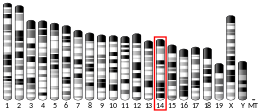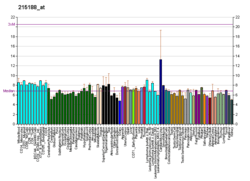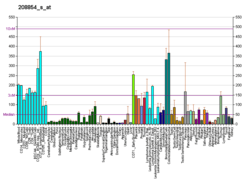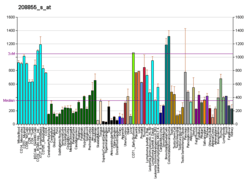STK24
Serine/threonine-protein kinase 24 is an enzyme that in humans is encoded by the STK24 gene [5][6][7] located in the chromosome 13, band q32.2. It is also known as Mammalian STE20-like protein kinase 3 (MST-3).[8] The protein is 443 amino acids long and its mass is 49 kDa.[8]
Classification and discovery
The yeast 'Sterile 20' gene (STE20) functions upstream of the mitogen-activated protein kinase (MAPK) cascade. In mammals, protein kinases related to STE20 can be divided into 2 subfamilies based on their structure and regulation. Members of the PAK subfamily (see PAK3) contain a C-terminal catalytic domain and an N-terminal regulatory domain that has a CDC42-binding domain. In contrast, members of the GCK subfamily (MAP4K2), also called the Sps1 subfamily, have an N-terminal catalytic domain and a C-terminal regulatory domain without a CDC42-binding domain. STK24 belongs to the GCK subfamily of STE20-like kinases.[6][7]
The sterile 20 protein was first found in yeast.[9] The MST-20 related kinases family is growing, having 28 members divided into two groups - p21-activated kinase and germinal center kinase (GCK) families.[10] STK24 belongs to the germinal center kinase (GCK) III subfamily of sterile 20 kinases.
Function
Kinases of GCKIII subfamily are involved in regulation of multiple functions of the cells[10] and interaction with programmed cell death 10 (CCM3).[11] CCM is a pathological vascular situation that, influencing the blood vessels in central nervous system (CNS), may cause stroke, seizure and even cerebral hemorrhage.[12] It has been shown that STK24 and STK25 operate in the same cardiovascular development pathway with CCM3. According to the results of the experiment by Zhang et al.,[12] lack of STK24 has no effect on the amount of neutrophils or leucocytes, as well as it does not affect the chemotaxis of neutrophils.[12] Zhang et al. also the interaction between STK24 and CCM. Using tandem affinity purification with mass spectrometry, they found that CCM3 is the main protein that binds to STK24 in HEK293 cells.[12]
STK24 operates on serine and threonine residues and, as a response to oxidative stress and caspase activity, develops cell death.[8]
STK24 is activated by autophosphorylation at Thr-190 and phosphorylation at this site is essential for its function. Phosphorylation by protein kinase A activates the isoform B of STK24.[8]
The mutagenesis of four residues in STK24 have been carried out. In position 18, the replacement of threonine (T) with alanine (A) causes the reduction of phosphorylation by PKA.[6] the modification in positions 65, where lysine (K) is replaced with A, and the position 190, where T is replaced with A, affects the activity and autophosphorylation.[10] In residue 321, the change of aspartic acid (D) to Asparagine (N) reveals as loss of proteolytic cleavage by caspases.[10] Those residues may play an important role apoptotic signal transduction.[10]
Structure and tissue distribution
STK24 has two subunits, 36kDa N-terminal subunit and 12 kDa C-terminal subunit.[8] In the cells, STK24 is located in nucleus and less in cytoplasm and membrane. There are two isoforms of the protein, isoform A is ubiquitous and is expressed in 237 organs, isoform B is expressed in brain hippocampus and cerebral cortex.[8]
Interactions
STK24 has been shown to interact with PDCD10,[13][14][15] TRAF3IP3,[15] STRN3,[14][15] MOBKL3,[14][15] STRN,[14][15] SLMAP,[14][15] PPP2R1A,[14][15] CTTNBP2NL,[15] FAM40A[14][15] and STRN4.[14][15]
References
- GRCh38: Ensembl release 89: ENSG00000102572 - Ensembl, May 2017
- GRCm38: Ensembl release 89: ENSMUSG00000063410 - Ensembl, May 2017
- "Human PubMed Reference:". National Center for Biotechnology Information, U.S. National Library of Medicine.
- "Mouse PubMed Reference:". National Center for Biotechnology Information, U.S. National Library of Medicine.
- Schinkmann K, Blenis J (November 1997). "Cloning and characterization of a human STE20-like protein kinase with unusual cofactor requirements". The Journal of Biological Chemistry. 272 (45): 28695–703. doi:10.1074/jbc.272.45.28695. PMID 9353338.
- Zhou TH, Ling K, Guo J, Zhou H, Wu YL, Jing Q, Ma L, Pei G (January 2000). "Identification of a human brain-specific isoform of mammalian STE20-like kinase 3 that is regulated by cAMP-dependent protein kinase". The Journal of Biological Chemistry. 275 (4): 2513–9. doi:10.1074/jbc.275.4.2513. PMID 10644707.
- "Entrez Gene: STK24 serine/threonine kinase 24 (STE20 homolog, yeast)".
- "STK24 - Serine/threonine-protein kinase 24 - Homo sapiens (Human) - STK24 gene & protein". www.uniprot.org. Retrieved 2018-11-10.
- Ramer SW, Davis RW (January 1993). "A dominant truncation allele identifies a gene, STE20, that encodes a putative protein kinase necessary for mating in Saccharomyces cerevisiae". Proceedings of the National Academy of Sciences of the United States of America. 90 (2): 452–6. doi:10.1073/pnas.90.2.452. PMC 45681. PMID 8421676.
- Huang CY, Wu YM, Hsu CY, Lee WS, Lai MD, Lu TJ, Huang CL, Leu TH, Shih HM, Fang HI, Robinson DR, Kung HJ, Yuan CJ (September 2002). "Caspase activation of mammalian sterile 20-like kinase 3 (Mst3). Nuclear translocation and induction of apoptosis". The Journal of Biological Chemistry. 277 (37): 34367–74. doi:10.1074/jbc.M202468200. PMID 12107159.
- Fidalgo M, Fraile M, Pires A, Force T, Pombo C, Zalvide J (April 2010). "CCM3/PDCD10 stabilizes GCKIII proteins to promote Golgi assembly and cell orientation". Journal of Cell Science. 123 (Pt 8): 1274–84. doi:10.1242/jcs.061341. PMID 20332113.
- Zhang Y, Tang W, Zhang H, Niu X, Xu Y, Zhang J, et al. (October 2013). "A network of interactions enables CCM3 and STK24 to coordinate UNC13D-driven vesicle exocytosis in neutrophils". Developmental Cell. 27 (2): 215–226. doi:10.1016/j.devcel.2013.09.021. PMC 3834565. PMID 24176643.
- Rual JF, Venkatesan K, Hao T, Hirozane-Kishikawa T, Dricot A, Li N, et al. (October 2005). "Towards a proteome-scale map of the human protein-protein interaction network". Nature. 437 (7062): 1173–8. Bibcode:2005Natur.437.1173R. doi:10.1038/nature04209. PMID 16189514.
- Ewing RM, Chu P, Elisma F, Li H, Taylor P, Climie S, et al. (2007). "Large-scale mapping of human protein-protein interactions by mass spectrometry". Molecular Systems Biology. 3 (1): 89. doi:10.1038/msb4100134. PMC 1847948. PMID 17353931.
- Goudreault M, D'Ambrosio LM, Kean MJ, Mullin MJ, Larsen BG, Sanchez A, et al. (January 2009). "A PP2A phosphatase high density interaction network identifies a novel striatin-interacting phosphatase and kinase complex linked to the cerebral cavernous malformation 3 (CCM3) protein". Molecular & Cellular Proteomics. 8 (1): 157–71. doi:10.1074/mcp.M800266-MCP200. PMC 2621004. PMID 18782753.
Further reading
- Christian SL, McDonough J, Liu Cy CY, Shaikh S, Vlamakis V, Badner JA, Chakravarti A, Gershon ES (May 2002). "An evaluation of the assembly of an approximately 15-Mb region on human chromosome 13q32-q33 linked to bipolar disorder and schizophrenia". Genomics. 79 (5): 635–56. doi:10.1006/geno.2002.6765. PMID 11991713.
- Huang CY, Wu YM, Hsu CY, Lee WS, Lai MD, Lu TJ, Huang CL, Leu TH, Shih HM, Fang HI, Robinson DR, Kung HJ, Yuan CJ (September 2002). "Caspase activation of mammalian sterile 20-like kinase 3 (Mst3). Nuclear translocation and induction of apoptosis". The Journal of Biological Chemistry. 277 (37): 34367–74. doi:10.1074/jbc.M202468200. PMID 12107159.
- Lee WS, Hsu CY, Wang PL, Huang CY, Chang CH, Yuan CJ (August 2004). "Identification and characterization of the nuclear import and export signals of the mammalian Ste20-like protein kinase 3". FEBS Letters. 572 (1–3): 41–5. doi:10.1016/j.febslet.2004.07.007. PMID 15304321.
- Stegert MR, Hergovich A, Tamaskovic R, Bichsel SJ, Hemmings BA (December 2005). "Regulation of NDR protein kinase by hydrophobic motif phosphorylation mediated by the mammalian Ste20-like kinase MST3". Molecular and Cellular Biology. 25 (24): 11019–29. doi:10.1128/MCB.25.24.11019-11029.2005. PMC 1316964. PMID 16314523.
- Lu TJ, Lai WY, Huang CY, Hsieh WJ, Yu JS, Hsieh YJ, Chang WT, Leu TH, Chang WC, Chuang WJ, Tang MJ, Chen TY, Lu TL, Lai MD (December 2006). "Inhibition of cell migration by autophosphorylated mammalian sterile 20-like kinase 3 (MST3) involves paxillin and protein-tyrosine phosphatase-PEST". The Journal of Biological Chemistry. 281 (50): 38405–17. doi:10.1074/jbc.M605035200. PMID 17046825.
- Olsen JV, Blagoev B, Gnad F, Macek B, Kumar C, Mortensen P, Mann M (November 2006). "Global, in vivo, and site-specific phosphorylation dynamics in signaling networks". Cell. 127 (3): 635–48. doi:10.1016/j.cell.2006.09.026. PMID 17081983.







